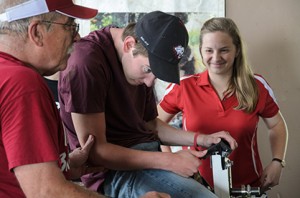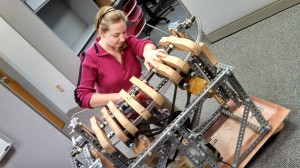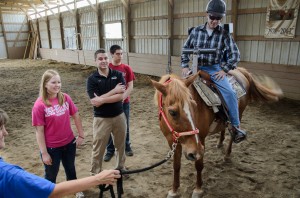Equine Robotica: Bio-Medical Students Collaborate With Therapeutic Riding Center to Create Riding Simulator
By: Brittany Bevis
For the past thirteen years, Christy Menke has served as the Founder and Executive Director of therapeutic riding center Hope Haven Horse Farm. As a PATH certified instructor and registered nurse, her passions have always had a split focus.
“I have always questioned why, what, when, and how we could better the way we teach both for the [riders] and volunteers,” Menke says. “As my staff knows, there is a very fast, little hamster that runs non-stop in my brain. I have even sketched some of my ‘inventions’ in an effort to toy around with them someday. Well, that someday has come, and I’m in awe.”
“When I was first approached by the Rose-Hulman biomedical engineering professors, they weren’t sure exactly ‘how they were going to help a horse farm.’ Taking a risk of sounding absolutely crazy, by letting the hamster out, was a risk I felt well worth taking.”
By combining Menke’s “out-of-the-box” concepts with the technical expertise of biomedical students at the Rose-Hulman Institute of Technology, a wonderful collaboration was born that’s already producing great results in the therapeutic riding community. The resulting Rose-Hulman/Christy Project is focused on increasing the physical goals of riders by providing hard statistical data through a series of very unique horse-themed inventions.
To begin, Hope Haven identified the five groups that are most represented in the field of therapeutic riding, including traumatic brain injuries, Cerebral Palsy, Autism, MR/DD, and Down Syndrome. In March 2014, the full-blown project will debut the new technology designed by the students along with lessons given by certified PATH riding instructors.
Some of the technological marvels include a “horse simulator” that mimics the four-beated walk of the horse, allows for a decrease in muscle spasms, and an increase in core strength and balance. An “upper body biofeedback mechanism” will provide data on a rider’s upper body stability, shifting, and balance. There’s also a new system in the works for riders, who utilize a wheelchair for mobility, to feel correct posture and gain independence.
“The simulator was designed with a replication of the horse’s spine and rib cage to provide the closest feeling to riding bareback as possible,” she says. “Riders sit on a pad that sits on the simulator, and one to two volunteers assist on each side. When turned on, [the simulator] will mimic the exact four-beat walk of the horse. It attaches to an iPad that allows for us to time the session, choose between a slow, medium, or fast walk and a narrow, average, and wide horse, by utilizing padding. Eventually, plans are to add a visual component to gauge rein pressure if we so choose to add reins.”
Menke hopes to use the horse simulator for riders with severe Cerebral Palsy and traumatic brain injuries, for inclement weather when horses cannot be used, and to create an option where no leaders or side-walkers would be needed.
“For therapeutic riding centers, it’s no mystery that the three dimensional four-beated walk of the horse mimics the human walk,” she says. “The horse’s walk not only provides riders with the sensation of walking but is instrumental in strengthening the muscles utilized for walking, trunk strengthening, core balance, and relaxation of muscles and spasms as well.”
One rider that has already benefitted from this new technology is former Rose-Hulman student, Drew Christy, who sustained a traumatic brain injury during a near fatal car crash during his sophomore year. With only a 1% survival rate, it wasn’t thought that Christy would be able to make the strides he has since the accident.
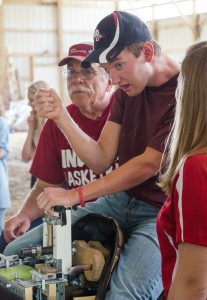
Drew Christy trying out the simulator. Image courtesy of The Rose-Hulman Institute of Technology. Photo Credit: Chris Minnick.
In May of 2012, four side walkers were needed to assist Christy with riding horseback. Within only five minutes, his endurance was gone, and his head would droop to the saddle horn. In June of 2013, he used the simulator for four weeks. From July 2013 until now, Christy can ride with only one side walker, has enough core strength to maintain his balance, can make large tight turns and shift his weight on horseback, and is working on riding with no hands to increase upper body strength.
Some might ask, why use Equine Robotica when you can ride the real thing? Menke explains.
“Although we’re utilizing it in combination with lessons, we see a potential for the simulator to be successful for those who cannot ride,” she says. “As the inspiration behind it is comparable to a massage device, it also mimics the horse’s walk and simulates bareback riding. Many of the ways we can see the device benefitting those who can or don’t ride include but are not limited to: fear of riding, physically unable to safely mount a live horse, weight challenges of being able to safely ride a horse, and massage or physical therapy type simulated equine assistance for those outside of the riding industry.”
Additional projects coming down the pipeline include “The Stabilizer,” a bio-feedback mechanism housed in a vest and attached to sunglasses. This device will provide statistical data on the shifts in a rider’s upper body balance and visual and audible cues to alert the rider of shifts for more independence. “Supporting Saddles 1.0” is a support system for the saddle that will provide lower lumbar support, handle bar support, stirrup adjustment back and forth, and even shoulder support for riders that utilize wheelchairs.
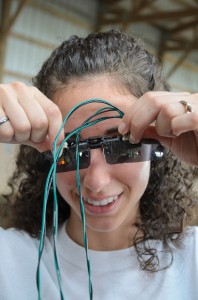
Student Tonya Colonna shows the sunglasses. Image courtesy of The Rose-Hulman Institute of Technology. Photo Credit: Chris Minnick.
A “lower leg biofeedback device” will gather data on the pressure a rider exerts in the stirrups and measure foot angles in the stirrups. Finally, a mechanical horse head with an aluminum base and neck comprised of wooden vertebrae will react to rein pressure in a manner similar to a real horse. Riders will be able to pull right or left and the head will respond accordingly.
Although these inventions were created to assist non-able bodied riders, Menke can envision the final products having applications in the larger equestrian industry as well.
“We see absolutely no reason that, eventually as the prototypes are developed, the biofeedback, simulator, and mechanical horse head would not prove extremely useful with able bodied riders,” she says. “Beginner riders could benefit from all of the above as well as the most disciplined of riders. As a past Dressage and Show Jumper, I would have loved to have had a biofeedback mechanism that could have told me where my position was during a ride!”
“The mechanical horse head could be utilized to teach anyone proper hand placement and rein pressure and will be such a wonderful teaching tool for non-able bodied riders and able bodied riders.”
Menke would like to express her thanks to The Rose-Hulman Institute of Technology and all of the hard-working students that have made her dreams into reality.
“They have gone above and beyond my visions, and it’s amazing to see their minds and skills accomplish what I had deemed the impossible,” she says. “I am blessed. I am blessed by the professors, the students, our clients, our staff, our volunteers, and the magical beast we know as the horse. This collaboration has brought such an intense passion to the new direction that we are going in and hopes for a change in the industry as we know it.”
If you’d like to help with funding for this exciting project, Hope Haven’s contact information is as follows.
Address: 10416 E. US Hwy 40, Coatesville, IN 46121
Phone: 317-641-5716
Website: www.hopehavenhorsefarm.com
Contact: Christy Menke (Founder/Executive Director): cmenke@hopehavenhorsefarm.com
Face book: https://www.facebook.com/#!/Hopehavenfarm










